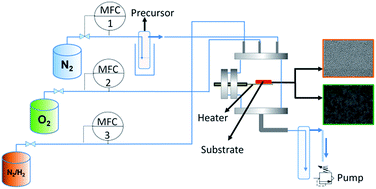Bis(β-diketonato)- and allyl-(β-diketonato)-palladium(ii) complexes: synthesis, characterization and MOCVD application†
Abstract
The syntheses and characterization of the palladium complexes [Pd(accp)2] (7), [Pd(acch)2] (8), [Pd(η3-CH2CMeCH2)(accp)] (11), [Pd(η3-CH2CMeCH2)(acch)] (12), [Pd(η3-CH2CtBuCH2)(accp)] (13) and [Pd(η3-CH2CtBuCH2)(acch)] (14) (accp = 2-acetylcyclopentanoate; acch = 2-acetylcyclohexanoate) are reported. These complexes are available by the reaction of Haccp (2-acetylcyclopentanone) and Hacch (2-acetylcyclohexanone) with Na2[Pd2Cl6] forming 7 and 8 or with [(Pd(η3-CH2CRCH2)(μ-Cl))2] (9, R = Me; 10, R = tBu) forming 11–14. The molecular structures of 7, 8 and 14 are discussed. Complexes 7 and 8 consist of a square-planar coordinated Pd atom with two trans-positioned bidentate β-diketonate ligands. The asymmetric unit of 14 exhibits one molecule of the palladium complex and a half molecule of water. The thermal behavior of 7, 8 and 11–14 and their vapor pressure data were investigated to show, if the appropriate complexes are suited as CVD precursors for palladium layer formation. Thermogravimetric studies showed the evaporation of the complexes at atmospheric pressure upon heating. The vapor pressure of 7, 8 and 11–14 was measured by using thermogravimetric analysis, giving vapor pressure values ranging from 0.62 to 2.22 mbar at 80 °C. Chemical vapor deposition studies were carried out applying a vertical cold wall CVD reactor. Either oxygen or forming gas (N2/H2, ratio 90/10, v/v) was used as reactive gas. Substrate temperatures of 350 and 380 °C were utilized. With 11–14 dense and conformal as well as particulate palladium films were obtained, as directed by SEM studies, whereas 7 and 8 failed to give thin films, which is probably attributed to their high thermal stability in the gas phase. For all deposited layers, XPS measurements confirmed the partial oxidation of palladium to palladium(II) oxide at 380 °C, when oxygen was used as reactive gas. In contrast, thin layers of solely metallic palladium were obtained utilizing forming gas during the deposition experiments.


 Please wait while we load your content...
Please wait while we load your content...